Ski: 2020-2021 Liberty Origin 96, 187 cm
Available Lengths: 171, 176, 182, 187 cm
Blister’s Measured Tip-to-Tail Length: 185.7 cm
Blister’s Measured Weight per Ski: 1966 & 1973 grams
Stated Dimensions: 130-96-118 mm
Blister’s Measured Dimensions: 130.1-96.3-117.9
Stated Sidecut Radius: 20 meters
Measured Tip & Tail Splay (ski decambered): 63 mm / 35 mm
Measured Traditional Camber Underfoot: ~3 mm
Core: Poplar/Bamboo + Carbon Stringers + Fiberglass Laminate
Factory Recommended Mount Point: -8.15 cm from center; 84.7 cm from tail
Ski: 2016-2017 Liberty Origin 96, 187 cm
Available Lengths: 171, 176, 182, 187 cm
Blister’s Measured Tip-to-Tail Length: 185.7 cm
Stated Dimensions: 130-96-118 mm
Blister’s Measured Dimensions: 129-95.5-117 mm
Blister’s Measured Weight per Ski: 1991 & 1997 grams
Stated Sidecut Radius: 20 meters
Measured Tip & Tail Splay (ski decambered): 73 mm / 36 mm
Measured Traditional Camber Underfoot: ~4 mm
Core: Poplar/Bamboo + Carbon Stringers + Fiberglass Laminate
Factory Recommended Mount Point: 7.45 cm behind center; ~85.4 cm from tail
Boots / Bindings: Nordica Strider 120 / Tyrolia AAAttack 13 demo
Test Locations: Crested Butte & Arapahoe Basin, CO
Days Skied (18/19 Origin 96): 10
[Note: Our review was conducted on the 18/19 Origin 96, which was not changed for 19/20 or 20/21, apart from graphics.]

Intro
Two years ago when he reviewed the Liberty Origin 96, Jonathan Ellsworth called it “tenacious,” and said that he’d never really skied anything like it. He found it to be a surprisingly strong ski that, when combined with its radically deep rocker lines, made for a really fun time in a lot of different conditions.
But for the 18/19 season, Liberty is dialing back the Origin 96’s tip rocker — and they’re doing the same for the Origin 90 and women’s Genesis 90 and Genesis 96, too.
What Liberty says about the new Origin 96:
“The award-winning Origin 96 is back with a newly refined, early rise tip profile. With more edge contact in varied conditions, the Origin 96 is ready to carve harder than ever before, but still retains a playful personality everywhere on the mountain. With bamboo, poplar, and carbon fiber, energy and stability are what you can count on.”
So the new Origin 96 is supposed to perform better on firm and variable snow, which seems like a logical expectation given the new ski’s decreased tip rocker and splay.
Shape / Rocker Profile
Liberty says the Origin 96’s tip rocker is the only thing that’s changed between the 17/18 and 18/19 versions. The new ski has a slightly shallower tip rocker line, and noticeably less tip splay (63 mm on the new ski vs. 73 mm on the previous version).
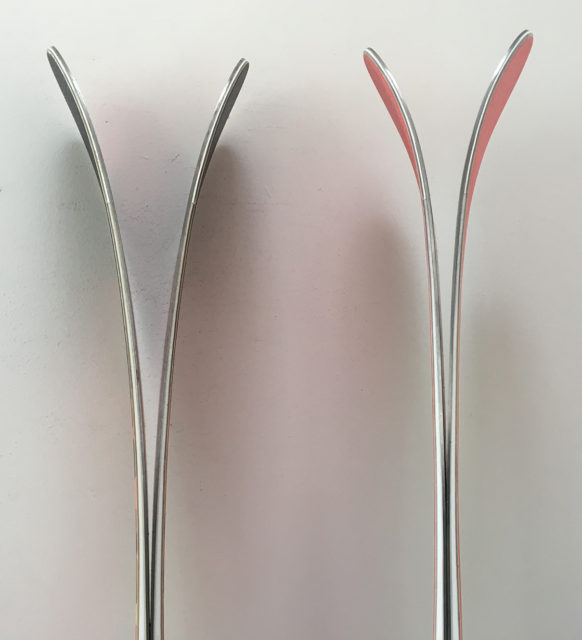
Overall, the new Origin 96 still has deeper rocker lines than some of the more traditional options in this class (e.g., Blizzard Bonafide, Volkl Mantra M5, 4FRNT MSP 99). So while Liberty is emphasizing the new Origin 96’s improved carving performance, their note about it retaining a playful personality sounds accurate.
Flex Pattern
Here’s how we’d characterize the flex pattern of the Origin 96:
Tips: 6
Shovels: 6.5-7.5
In Front of Toe Piece: 9-10
Underfoot: 10
Behind Heel Piece: 9.5-8.5
Tails: 8-7
The Origin 96 has a fairly round flex pattern that starts pretty soft in the tip, then ramps up smoothly to a very supportive section around the bindings, and finishes with a tail that’s a bit stiffer than the tips. Compared to the old Origin 96 we reviewed, the new version’s flex pattern feels nearly identical, with the new ski’s tails being just slightly softer.
The Origin 96 definitely doesn’t have a super burly flex pattern, but Jonathan emphasized how strong the old Origin 96 felt thanks to its stiffer section underfoot, so we have reason to think that the same will hold true for the new version.
Weight
Like the previous version, the new Origin 96 is a bit lighter than many all-mountain skis in this waist width. But given the industry-wide trend we’ve been seeing of all-mountain skis getting lighter and lighter, the Origin 96 isn’t doesn’t look quite as light as it used to.
For reference, below are a few of our measured weights (per ski, in grams) for a few notable skis. As always, keep in mind the length differences to keep things apples-to-apples.
1734 & 1750 Renoun Endurance 98, 184 cm (18/19)
1896 & 1919 Dynastar Legend X96, 186 cm (17/18, 18/19)
1921 & 1968 Head Kore 99, 189 cm (18/19)
1925 & 1937 Liberty Helix 98, 186 cm (18/19)
1966 & 1973 Liberty Origin 96, 187 cm (18/19)
1991 & 1997 Liberty Origin 96, 187 cm (17/18)
1998 & 2044 4FRNT MSP 99, 181 cm (17/18, 18/19)
2007 & 2029 Armada Invictus 99 Ti, 187 cm (18/19)
2049 & 2065 Volkl Mantra M5, 177 cm (18/19)
2053 & 2057 Atomic Vantage 97 Ti, 188 cm (18/19)
2115 & 2149 J Skis Masterblaster, 181 cm (17/18, 18/19)
2124 & 2137 Blizzard Bonafide, 180 cm (17/18, 18/19)
2131 & 2189 Nordica Enforcer 100, 185 cm (17/18, 18/19)
2373 & 2397 Head Monster 98, 184 cm (17/18)
Some Questions / Things We’re Curious about
(1) The old Origin 96 was one of the best ~95mm-underfoot skis we used when it came to performance in deep snow. So will the new ski’s decreased tip rocker and splay dramatically hinder the ski in pow? Or will it still sit near the top of this class when it comes to float?
(2) On the opposite end of the conditions spectrum — how much better will the new Origin 96 be on firm snow?
Bottom Line (For Now)
The old Liberty Origin 96 stood out from the competition in large part due to its significant amount of tip rocker and splay. And we really liked that ski. So now that Liberty mellowed out the Origin 96’s rocker profile, is the new ski more versatile? And how does this new model measure up against the many other skis in this class?
Blister members can check out our initial on-snow impressions in our Flash Review, and while we compile our full review let us know in the Comments section below anything you’d like us to address in the full review.
Flash Review
Blister Members can now check out our Flash Review of the Origin 96 for our initial impressions. Become a Blister member now to check out this and all of our Flash Reviews, plus get exclusive deals and discounts on skis, and personalized gear recommendations from us.
FULL REVIEW
Jonathan Ellsworth and I started skiing the updated Origin 96 on the slushy terrain at A-Basin last spring, and we’ve also been spending time on it at Crested Butte this winter. In fact, I was just skiing it at Crested Butte 15 minutes before I sat down to write this. We don’t always rush to write reviews that quickly, but I was having an absolute blast on the Origin 96, so I was eager to tell you all why. But first…
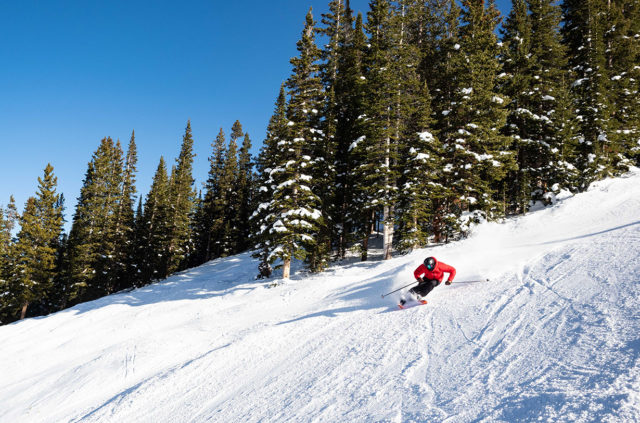
What we said about the Origin 96 in our 18/19 Winter Buyer’s Guide:
“Honestly, we could pretty easily put this ski in either our “More Forgiving” or “More Stable” section, because the Origin 96 is a fairly light ski that can be skied quite hard for its weight, yet it remains quite forgiving. The new, revised Origin 96 has less tip splay and a shallower tip rocker line, and it feels a bit more precise than the previous version, while still retaining a slightly more playful feel than some of the skis here (it’s pretty easy to slide around). So while it’s more forgiving than a lot of the skis in our “More Stable” section, we’d still call this ski “tenacious” — it’s definitely not the dampest ski out there, but if you stay fairly light on your feet, the Origin 96 accommodates an aggressive skiing style, from railing groomers, zipperlining bumps, or mobbing through spring slush.”
Steep Off-Piste Terrain
Crested Butte recently started running their High Lift, which opened up the iconic Headwall and a bunch of other steep, technical terrain. For this sort of terrain and the skiing style it requires (e.g., lots of quick, small turns), the Origin 96 seemed almost perfect.
The Origin 96 feels really light and is also quite easy to break free and slide around. Those are both great traits for steep terrain where I’m not hitting super high speeds and instead need to precisely pick my way through my line. The Origin 96 didn’t get hung up in the 8-15” of fresh snow left over from the recent storm, and it also held an edge pretty well when I needed it to.
I kept thinking of two words while skiing the Origin 96 — “precise” and “tenacious.” It feels super nimble and is very easy to flick around in the air and on the snow, but at the same time, it’s super fun to ski very hard with a dynamic / active style.
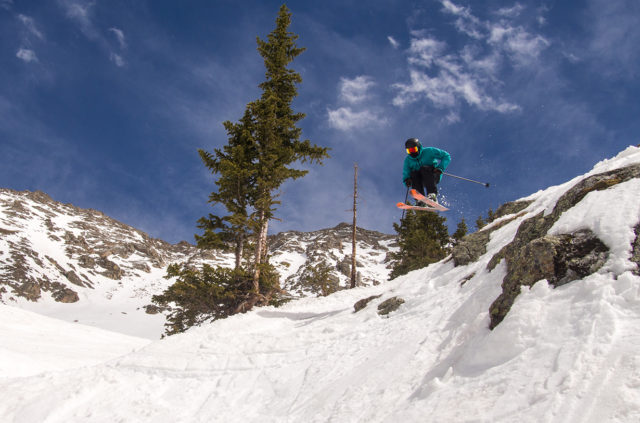
Bigger or very aggressive skiers may find themselves overpowering the shovels of the Origin 96, but I never had any real issues with it, even when driving it pretty hard.
Overall, the Origin 96’s combination of (1) low weight, (2) decent edge hold, (3) ability to slide / pivot, and (4) strong but forgiving flex pattern made it really intuitive and confidence inspiring in steep terrain.
Groomers
On groomers the Origin 96 is, again, intuitive and predictable. It initiates turns easily and I could easily make big GS turns or bend it into tighter ones. It also produces a good deal of energy coming out of a carved turn.
There are several skis in this class that offer better edge hold, but I was happy with the Origin 96’s edge hold on anything softer than ice. And unlike those skis with better edge hold, the Origin 96 is very easy to break into slides and slashes. As a result, the Origin 96 feels equally comfortable skiing pretty hard and fast or while relaxing and sliding your turns around. And when I combined those two styles, the Origin 96 was a ton of fun — get some speed going, carve a hard turn, then find a windlip and lay down a big, extended slash. Again, I think “tenacious” is the right word to describe this ski.
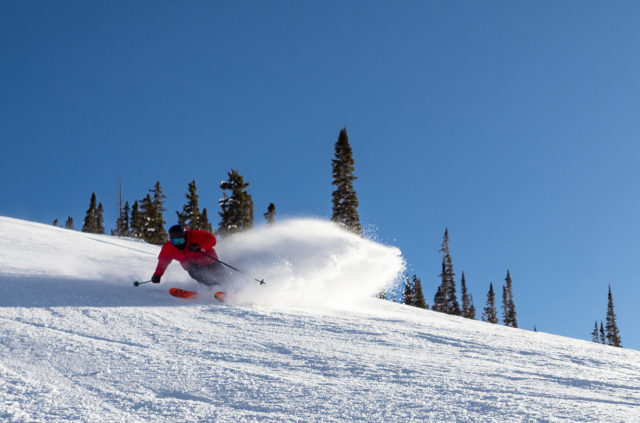
If the groomers were fairly soft and / or fairly smooth, I could go quite fast on the Origin 96 without it getting knocked around. But at the end of the day when all the snow had been pushed around, I definitely found myself having to slow down and avoid hitting the patches of snow head-on.
So if you like to mob down groomers and like a ski that will smooth out inconsistencies in the snow, I’d recommend checking out a heavier ski. But if you either take a more casual, slower approach to groomers or are willing to be more deliberate with your line choice and avoid smashing into piles of snow, the Origin 96 is a very competent groomer ski.
Moguls
I think the Origin 96 falls on the slightly easier end of the spectrum when it comes to bumps. Its low weight and tip and tail rocker make it easy to make quick adjustments in bumps, and the forgiving flex in its tips and tails make it less punishing than many other ~96 mm skis.
The Origin 96, at least in the 187 cm version we’ve been skiing, won’t let you ski completely backseat in bumps — the section behind the bindings is still pretty stiff, and there are easier skis out there if you want maximum forgiveness in bumps. But the Origin 96 is still pretty forgiving in moguls, and I think it offers a nice blend of forgiveness and support that makes it a good ski to use while trying to improve your technique in bumps.
Powder
The 18/19 Origin 96 has less tip rocker and splay than the last version, so I was curious to see how it’d perform in fresh snow. After taking it out in the leftovers of a recent 15” storm cycle in Crested Butte, I think it’s still one of the better skis in its waist width when it comes to performance in powder. The Origin 96’s tips never dove on my while skiing through ~12” of fresh or cut-up pow, and it remained pretty easy to pivot in the deeper snow, despite its narrower width. I think the Origin 96’s performance in pow makes it a great 1-ski quiver for lower-snow areas.
Soft Chop
In soft, cut-up snow the Origin 96 continued to be predictable and punched above its width. It doesn’t blast through patches of chop like bigger, heavier, and / or stiffer skis, but I could still ski quite fast through soft chop on the Origin 96. Instead of mobbing straight through, I’d aim for the bigger patches and catch some air. And while it’s no crud-buster, the Origin 96’s tip rocker kept it from slicing into the snow unpredictably.
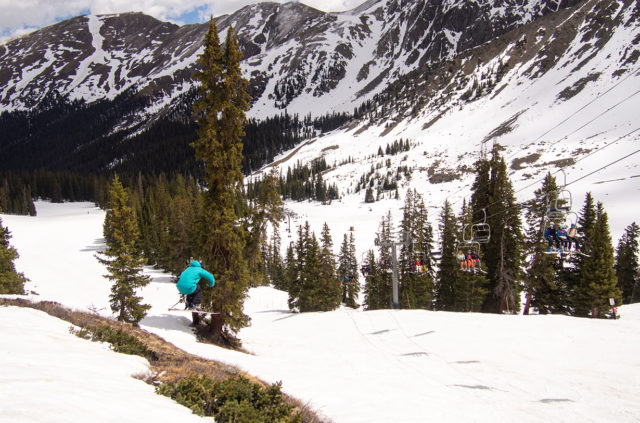
Crud
In areas where the chop had settled and hardened, I had to ski a lot slower and more carefully. The Origin 96 is not a super damp ski, and it felt harsh when skiing fast over and through crud. That said, I’d say it performed just as well, if not better than similarly light skis in these conditions. If you want a more damp and planted feel, look to heavier skis.
Playfulness
Like the Liberty Helix 98, the Origin 96 falls somewhere between traditional flat-tailed all-mountain skis and true freestyle skis when it comes to playfulness. The Origin 96 definitely feels best when skied with a bit of pressure on the front of the ski, but you can also ski it pretty centered. It’s much easier to slash and slide around compared to skis with less tip and tail rocker, though it’s not the surfiest ski in its class.
The Origin 96 feels very light in the air, which is great for quick shifties or spins, though it doesn’t feel as balanced as skis with mount points closer to center. But if you’re not throwing big spins the Origin 96 is still a ton of fun — it’s easy to break free from a turn, produces a lot of pop on takeoffs, provides a solid landing platform, and is easy to throw around.
Who’s It For?
I think a lot of skiers could get along well with the Origin 96.
I think it’d be a very good option for intermediate skiers who want a ski that’s forgiving but also strong enough that they can keep using it as they improve. And in the shorter lengths, I think beginner skiers could get along well with it, too.
At the same time, I think the Origin 96 could work very well for advanced or expert skiers who prefer a lighter ski and ski with a “light on your feet” style, rather than a very planted, get-down-the-hill-as-fast-as-possible style.
Those looking for a super damp feel should check out heavier skis (there are lots of good options in the “All-Mountain More Stable” section of our Buyer’s Guide). But if you’re looking for a fairly light ski that you can still ski very hard and that performs quite well on both firm snow and fresh snow, the Origin 96 is certainly worth a look.
Bottom Line
The Liberty Origin 96 is a ski that’s light and quick, but that also encourages an aggressive and dynamic skiing style. It holds up to pretty high speeds, yet it also very easy at slower speeds and in technical terrain. It can carve a clean turn on firm snow, yet it also floats very well for its width. All in all, it’s a very versatile and well-executed all-mountain ski.
Deep Dive Comparisons
Become a Blister Member or Deep Dive subscriber to check out our Deep Dive of the Origin 96 to see how it stacks up against the Liberty Helix 98, Atomic Bent Chetler 100, J Skis Masterblaster, Nordica Enforcer 100, 4FRNT MSP 99, Moment Commander 98, Renoun Endurance 98, K2 Pinnacle 95 Ti, Blizzard Rustler 9, and ON3P Wrenegade 96.

The factory recommended mount point has also changed slightly (-0.7 cm). That’s not much, except that the increase in effective edge comes from the shallower tip rocker, and thus, there’s in practice more “effective tip” than just +0.7 cm.
Interestingly, Liberty suggests a 5 cm mounting range, which is bound to be more (or?) than the change in effective tip. So, lots of room for experimentation…
Did this ski really need to get better at carving? I found it to have more than enough edgehold to rip groomers. Almost too much for this type of ski. In fact I found myself wanting to detune the tails a little bit but wanted to wait to get them into some tighter trees before doing such.
Also, doubling down on hard snow performance seems a little unnecessary with the introduction of the vmt series. Interested to hear kind of a head to head comparison of the O96 and VMT92
I found that the ski had excellent edge hold on everything besides pure, straight-up ice where something like a Bonafide would deal with much better. My hope is that this model will close the gap between the two skis but still retain a more playful feel and better soft snow performance.
I for one, think the changes will make the ski even better on groomers and ice. I think it might help in moguls as well. It is one of my favorite skis, and more grip is always better for an East Coast skier. I also moved my mount point back 4 cm and found the ski was much more balanced and had better grip. It was not quite as quick turning, but didn’t loose much. This worked on the 187cm length, but the 182 didn’t need to be moved. The new version with less rocker and a slightly rearward mount is doing a similar thing as I did. I like the ski best with a race tune (0.5 deg base, 3.0 deg side) and then dull the tips and tails back to the contact point. This let’s the ski carve and grip from the middle very well, even on ice, and allows it to pivot well in soft snow. I can slide my tails out in tight bumped up trees in complete control and regulate my speed. Its my best tree ski by far.
The only real negative is the tip is very numb and doesn’t pull the ski into a turn at all. How could it with all that rocker? The new version might allow the tip to hook up a little more and pull the ski into a turn. When Luke said the new version is a little more precise, I assume that is what he means. Having the tip carve a little better (and sooner) in moguls should be a good thing, too. I own the 187cm length, and have skied the 182 and 177 lengths. The 187 is more stable at speed, the 182 is quicker and probably the best length for overall performance. I bet Luke would like the 182 length even better.
At 6’3″ 260lbs am i “too big” as an advanced/expert skier 70% hardpack 30% soft snow.
Apologies, looks like part of this what cut off,. I was trying to ask if at my size, am I too big for this ski. I know it is described as being quite stiff. Will it hold up?
Mat, my opinion is the 187 cm length will work very well for you. I am 6’4″, 240-250lbs and it works great for me. If you are 70% hardback, tune the bottom with 0.5 deg / 3.0 side and detune tip and tail as desired. The ski carves from the stiff middle section, as opposed to the tip pulling you into a carve. That might have changed a little with the new ski with less rocker. I think that would be a good thing, as there is still plenty of rocker, and the write up seems to agree with that as well.
I am your size and the 187 cm length works great for me.
You’ve mentioned in a lot of articles about “overwhelming the tips” what exactly do you mean by that?
When I talk about “overwhelming the tips” of a ski I’m referring to when you drive the front of a ski hard and the tips fold up / are not supportive enough and you end up feeling like you’re going to fall over the front of the ski. It’s not an issue for most people, but big skiers and / or those who really push hard into the front of their boots sometimes choose skis with stiffer shovels / tips because skis with softer shovels / tips might not be supportive enough when skiing fast, carving hard, or driving a ski through variable snow. Hope that clears things up.
Do you think that the Origin 96 would serve as a good one-ski-quiver for Taos Ski Valley?
If I’m on the fence about sizing- 176 or 182, how much support am I going to lose sizing down? I’m 5’10, 170 in my birthday suit and would be using it on resorts around Calgary. I’m aggressive on groomers, and confident on anything but the absolute steepest terrain- hence the draw to the 176. Will the shorter length help me gain confidence there also, or would I be better off with the support of the 182? Thanks, you guys rock!
I picked up the 176’s on sale a few months ago and haven’t mounted them yet.
I’m off to Canada in a couple of weeks and I’m wondering if I’d be better off with the 182’s
Main concern is if the 182’s would feel too long in trees, bumps or steep terrain where I’m pushing my limits
Most reviews online where reviewers have skied multiple / all lengths prefer the 182i
84kg / 177 cm
185 / 5’10
What to do?
Cheers
Waz
Hi Waz,
What skis have you used in the past, which lengths were they, and did any of them feel particularly long or short? My initial thought is the 182, but that recommendation would depend on the other skis you’ve used and your thoughts on them.
Quick measurements
My K2 Rictors 167cm / 80mm have a running length of 145 and an effective edge maybe 150 (I enjoy these)
My Soul 7’s at 180cm / 106mm have a running length of 130 and an effective edge of 135 (these feel long sometimes but I dont use them much and then its typically been challenging wet sticky fresh snow)
The Origins at 176cm have a running length of 128 and an effective edge of 150
I’d say I’m at least a low end advanced skier
The Origins will mostly be resort all mountain but I will be butting shifts on then and they would be my tour ski – but this would not be a large percentage of their usage.
Cheers
Got it — I think the 176 cm is a safe bet then.
I’m a very advanced/expert telemark skier (5’9” 180lbs). I live in Vail and spend about 70% of the time in all types of conditions in the back bowls and 30% on the front side on moguls and groomers. I ski fast for telemark skier and am aggressive. I like to take all types of turns, but place a premium on quicker shorter turns, as well as jumping between turns. On groomers and smoother snow, I like to carve with pressure and really arc the ski and turn. A nimble ski that is also stable and edges well is what I am looking for, as well as one that is forgiving in the bumps. I would also be using this ski for powder days up to at least 12″. The Origin 96 appears to check off most, if not all, of these boxes. Would you agree? Would you consider this a good choice for a telemark ski? And if so, what length (176 or 182cm)? I would be putting 22 Design Axl bindings on them. Many thanks for any feedback you might have to share.
I’ll second Marc’s question as he just described mine perfectly. The only difference is I will be mounting with a Bishop BMF R binding and I’m 5’11” and 190 lbs. finding that perfect teleski can be tough these days
I’m looking at picking up a pair of these as I can get a great deal through work and my current work skis are delaming.
I’m 5’11 and 80kg (175?lbs) and mostly ski 187 Blizzard Bonafides atm which I love but cost 3 times as much for another pair.
Anyone know how these compare durability wise? I usually ski 200-250 days a year, bit less atm because of Covid.
Have you skied them with the bindings moved forward at all?
I’ve spent a bit of time skiing them at +1 and +2 cm in front of the recommended line. Doing so made them feel slightly more playful and balanced, though when I went +2, I did notice that they weren’t finishing carved turns quite as nicely and overall carving felt just a bit less intuitive to me. But if you wanted to make it a bit more playful, going +1 from the line is a safe bet.
The length question again….
I’m curious to hear your thoughts about 176cm vs 182cm.
I’m 5’9″ 160lbs. East Coast skier, likes skiing fast in trees, bumps, and steeps and playing with the features on the trail margin.
Ski lengths that work for me:
2006 K2 Seth Vicious 179cm (perfect)
20/21 Mantra M5 177cm (perfect)
20/21 Enforcer 1000 179cm (pretty good, maybe feels a hair short)
libertyskis.com suggests that at my height I should go with 171 or 177. The 171 clearly seems too short, but is the 177 also going to feel short? Since the Origin 96 has more rocker than the skis I listed above should I size up to 182cm?
COVID is really hampering demo options…
Luke, I think you’re around my size, but you were happy with 187cm? On the East Coast I’m not skiing as big and fast as you out west, so that’s why 177 vs 182 seems more reasonable for me.
Also, any insight yet on the 21/22 Origins??
Many thanks. love your reviews.
Update for anyone else making this same decision: I posed this question directly to the folks at Liberty, and they unequivocally recommended 182cm.
Am looking for a lighter tree/mogul/park ski and am wondering if this is it? I am probably a low expert (I ski everything on the mtn, but not hard charging either). I ski Bonafides in CO, so I can use them for ice/groomers and have Spurs for deep powder. Really looking for an easy to pivot ski for trees and moguls. The bones are pretty heavy and tiring (I am pushing 50, so don’t have the stamina I used to). Kids are into the park, so I am in there playing around as well, so I thought twin tips would be good. Nothing serious – small jumps, box slides, etc. Also thinking Bent Chetlers or Soul Riders for the twin tips, or maybe even Sky 7 if I skip the twin tips. Thoughts? Tough to demo these days…..
On the length question, I would steer clear of the 176 cm length unless you were a very small person, basically a 120 lb, 5’3″ woman. I have skied all three lengths and the 176 really struggles with enough effective edge to get grip. Some one 150lbs an up is too heavy to get good grip. The 182 cm does not ski long, it feels like most 175 cm skis, in terms of effective length. My friend who is 5’8″ and 165 lbs bought the 176 cm and immediately gave it to his wife and bought the 182 length and was happy. We moved the bindings around some for his wife on the 176 (moved them back -2 to -4 cm) and she adjusted to the ski and became happy. She was used to fully cambered carving skis and it felt short to her at first.